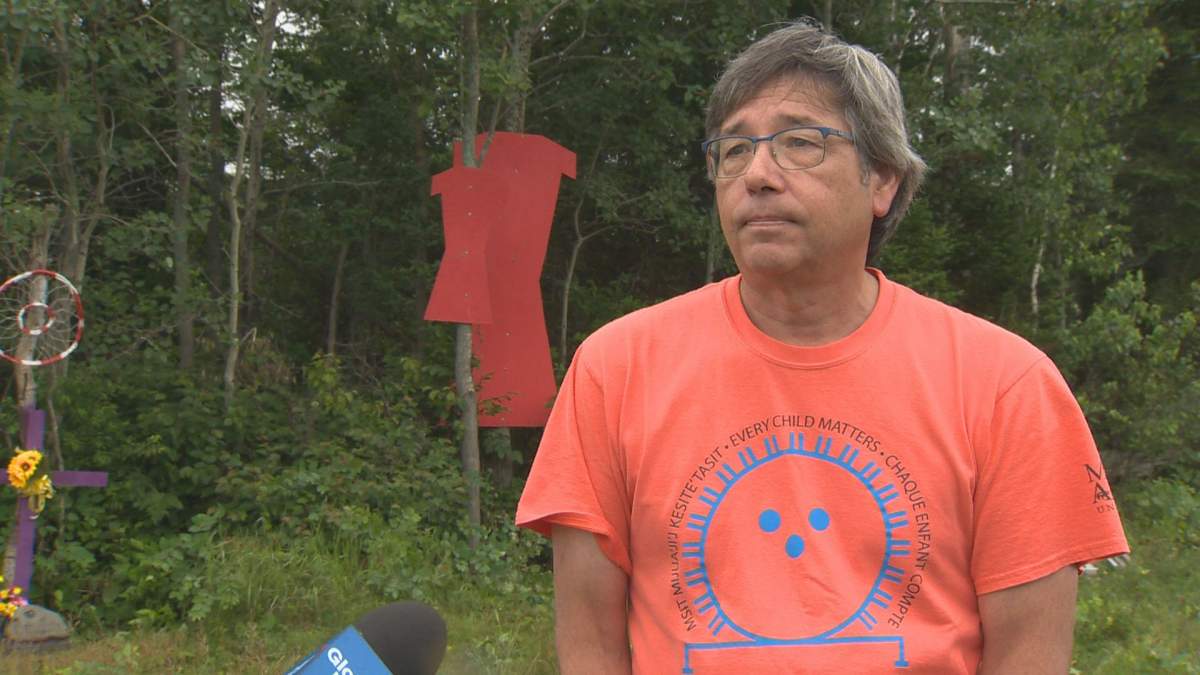Plywood red dress cutouts have been popping up in southeast New Brunswick and Fredericton lately to honour Missing and Murdered Indigenous Women and Girls (MMIWG) as part of the REDress Project.

Two red dresses were posted along the Trans-Canada Highway near Salisbury this weekend, where the body of Loretta Saunders — a 26-year-old Inuk woman from Labrador, who was a student at Saint Mary’s University — was found in 2014. Two people pleaded guilty to her murder and are currently serving their sentences.
Johnson, who has been designing and putting up about 36 of the dresses around the community, says it’s also important to make people think about injustices Indigenous people face.
“I think I’m raising awareness, but at the same time, I’m not yelling at anybody,” he says. “I’m not out there protesting, I’m not destroying anything… just trying to raise awareness with a simple red dress plywood cutout.”

Get daily National news
The dresses have been hung outside the Moncton courthouse, outside the Riverview RCMP station and along the Gunningsville Bridge heading to Riverview.
“We did this just to raise awareness and we’ve put them in places where there is injustice,” Johnson says.
- Officials stress Calgarians must save water after Bearspaw main break sees no drop in usage
- Yukon-Alaska border rocked by 3 earthquakes in final hours of 2025
- Snowmobiler dies in avalanche in Rocky Mountains in northeastern B.C.
- Canadians ring in 2026 with ‘invigorating’ polar plunges across the country
Andrea Colfer was also there; her sister Gladys Simon was missing for eight years before her partial remains were found in Restigouche County in 2012. She says it’s important to learn about all of the victims — and their stories.
“Please go on the computer, learn about what happened to Sabrina Polchies — she’s from my community too — and we have Tiffany Peters… people don’t mention these girls. Why? Their lives matter,” Colfer says. “Is it because they’re red like me? Their life is just as important as Loretta, as Gladys.”
But she says she’s concerned about injustices within indigenous communities also.
“This is a message I want to give all Indigenous people,” Colfer says. “We can not cry Red Lives Matter until we look at our own backyards.
“What kind of lateral violence are you perpetuating? What kind of lies are you covering up? What kind of hurt are you causing?”
“That’s my message for our communities before you start knocking on doors about you being treated misfairly, please look at your own behaviours in your own community,” she says. “What kind of lateral violence are you perpetuating? What kind of lies are you covering up? How are you hurting others?”
But for Johnson, he’s hoping the red dress movement will keep the conversation going and spark change.
“These are symbols of justice that our people just don’t get,” he says. “Time after time after time, we look for justice in the justice system and it’s just never there — and red dresses are just an expression of that frustration.”
And the fight to stop injustices towards Indigenous people is not ending anytime soon, says advocate Patty Musgrave, an Indigenous Affairs co-ordinator at Mount Allison University.
She points to a hashtag (#raggedyassed), which she attributes to Annie Mae Pictou-Aquash, a native rights advocate from Nova Scotia who was murdered in 1975.
“The hashtag means that we are to stay raggedy-assed, keep fighting, and by fighting, it doesn’t mean that it’s violence,” Musgrave tells Global News. “It means that we’re going to keep speaking up, we’re going to keep putting up red dresses, we’re going to keep have vigils, we’re going to keep telling the story.”










Comments